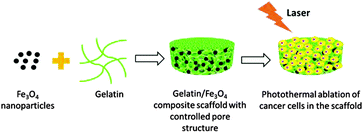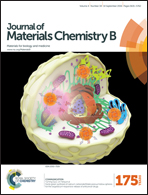Preparation of gelatin/Fe3O4 composite scaffolds for enhanced and repeatable cancer cell ablation
Abstract
Various nanomaterials have been extensively investigated for photothermal ablation of cancer cells because of their high photothermal conversion efficiency. However, the poor targeting specificity and low repeated heating efficiency of nanomaterials restrict their applications in the clinic. In this work, porous gelatin/iron oxide (Gel/Fe3O4) composite scaffolds were prepared by a facile ice particulate templating method for efficient and repeatable cancer cell ablation. Gel/Fe3O4 composite scaffolds showed controlled porous structure consisting of large pores and interconnecting small pores. The strong absorption in the near-infrared (NIR) region enabled the Gel/Fe3O4 composite scaffolds to elevate local temperature quickly under NIR laser irradiation. The composite scaffolds allowed cell adhesion and proliferation showing good biocompatibility. Cancer cells entrapped in the scaffolds could be efficiently killed during laser irradiation. Moreover, the therapeutic efficacy of Gel/Fe3O4 composite scaffolds could be enhanced by repeated laser irradiation treatment, which is important for clinical application because of the resistant and recurrent nature of cancer. The results indicated that the porous Gel/Fe3O4 composite scaffolds had good biocompatibility and excellent cancer cell ablation efficacy, which may provide an attractive way to use porous scaffolds for cancer therapy application.

- This article is part of the themed collection: 2016 Journal of Materials Chemistry B Hot Papers


 Please wait while we load your content...
Please wait while we load your content...